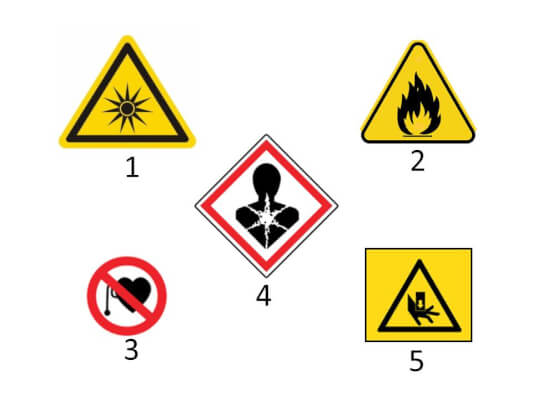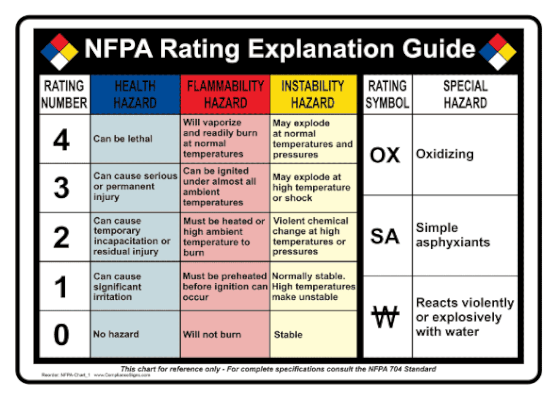Hazard Signs – Which do you recognize?
We so often prepare for big weather events that it’s easy to overlook everyday situations that could turn into disasters in just a minute — or even a second. This Advisory addresses some of those emergencies-waiting-to-happen.
Remember “the old days” when we used to look forward to seeing signs along the highway?
Burma-shave signs were the best. Of course you had to be able to read them backwards. If you don’t know what I’m talking about, check with a friend who roamed the roads in the fifties. And see the P.S. for an example!
These days roadside billboards are restricted in many places, but as we drive we still are likely to see directional signs, advertising signs, and dozens of hazard signs.
Ignoring or not recognizing hazard signs could be life-threatening.
But, which ones are which?
A while back, we presented a quiz with some common signs. Today we have six more – and these are a lot less obvious. (There’s one easy one in the collection below, to be sure everyone gets at least one right!)
Which ones do you recognize FOR SURE?
 Know what these signs mean!
Know what these signs mean!
- Danger of optical radiation – refers to light: ultraviolet, visible and infrared. Too much can damage the cornea or retina of the eye.
- Flammable or highly flammable – readily combustible. (Note: the words flammable and inflammable can be used interchangeably!)
- Radio frequency hazard — danger to heart/pacemaker.
- Carcinogen – capable of causing cancer, particular danger to reproductive or respiratory organs.
- Pinch hazard – A point in between moving and stationary parts of a machine where — in this case – your hand can get caught.
Now, here’s one more that you have seen hundreds of times but may never have really focused on.
The NPFA “Fire diamond” or “Safety square”
 The National Fire Protection Agency started using these signs in the 1960s to help emergency crews know what is being stored inside a building, a tank, a truck, a pipeline, etc. Once you become aware of these signs, you’ll see them everywhere.
The National Fire Protection Agency started using these signs in the 1960s to help emergency crews know what is being stored inside a building, a tank, a truck, a pipeline, etc. Once you become aware of these signs, you’ll see them everywhere.
But exactly what do the colors and numbers mean?
Briefly, red indicates flammability, blue indicates level of health hazard, yellow indicates chemical reactivity, and white contains codes for special hazards. The numbers range from 0 (no hazard) to 4 (severe risk).
So our example #6, above, would be read as follows:
- Red, Flammability — 3. “Can be ignited under ambient conditions”
- Blue, Health –- 1. “Could cause irritation or temporary incapacitation”
- Yellow, Chemical — 0. “Normally stable”
Here’s the full chart – thanks to ComplianceSigns.com
(When you see the symbol at the bottom, right, you’ll see how important these are to fire fighters.)
 Setting off on a family trip? You can encourage “reading hazard signs” and “reading diamonds” as entertainment, as long as you can pry the kids away from their devices.
Setting off on a family trip? You can encourage “reading hazard signs” and “reading diamonds” as entertainment, as long as you can pry the kids away from their devices.
Virginia
Your Emergency Plan Guide team
P.S. More about Burma-Shave jingles. Burma-Shave was a brushless shaving cream that advertised its product on a series of signs along the road. Each line appeared on its own sign; you read them one at a time as you passed by. (If they were on the other side of the road, then you read them last-to-first, of course!) The signs often dealt with romance and grooming, but some were totally off the topic, like this one (Thanks to https://fiftiesweb.com/pop/burma-shave-1/ )
Her chariot
Raced 80 per
They hauled away
What had
Ben Her
Burma-Shave
P.P.S. And don’t forget the Beginners Hazard Sign Quiz – https://emergencyplanguide.org/nine-hazard-signs-a-quiz/. Use these quizzes to start a conversation with your family and your neighborhood emergency response group. This is stuff we all should be familiar with.

 What does that sign mean?
What does that sign mean?

